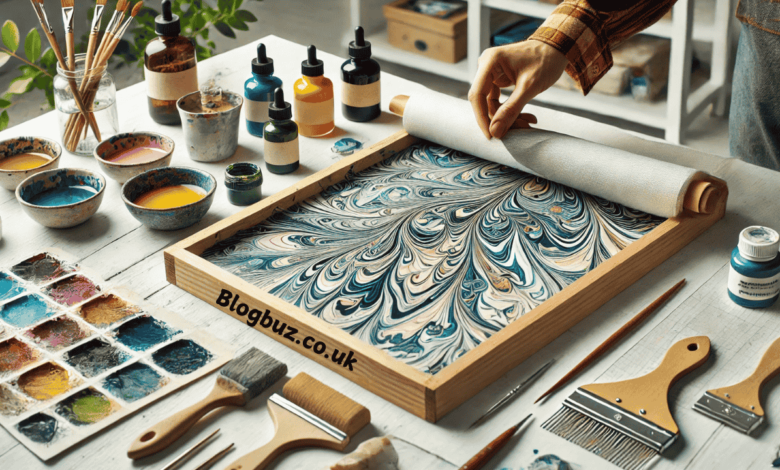Does Acrylic Stick to Tyvek Marbling? A Complete Guide to Acrylic Paint on Tyvek

Regarding unconventional surfaces for acrylic painting, Tyvek is one material that often sparks curiosity. Tyvek, a synthetic, non-woven material made from high-density polyethylene fibers, is most commonly used for mailing envelopes, protective clothing, and house wraps. However, its unique properties have also found a place in art, especially for marbling techniques. But the question remains: does acrylic stick to Tyvek marbling? This article explores the intricacies of marbling on Tyvek with acrylic paint, the challenges involved, and how to achieve the best results.
What Is Tyvek?
Before discussing how acrylic paint interacts with Tyvek, let’s first understand what Tyvek is. Tyvek is a synthetic material manufactured from high-density polyethylene fibers. It’s lightweight, durable, and water-resistant, often used for protective clothing, outdoor gear, and building materials. Tyvek has a smooth surface, which makes it challenging for many paints to adhere to without proper preparation.
However, its unusual texture and composition have also made it an interesting material for artists. In particular, Tyvek’s ability to hold marbling techniques is of great interest in the art world.
Understanding Acrylic Paint
Acrylic paint is a water-based medium popular among artists due to its fast drying time, vibrant color, and versatility. Acrylics adhere well to various surfaces, including canvas, wood, and paper. However, acrylic paint is especially tricky because it behaves differently depending on the surface to which it’s applied. Some surfaces, like canvas, absorb the paint, while others, like glass or plastic, create adhesion challenges.
When marbling with acrylics, the paint is typically floated on a layer of water, which allows it to form intricate patterns before being transferred onto a surface. This floating technique makes marbling an intriguing and artistic process but can also present challenges when working with non-porous surfaces like Tyvek.
The Challenges of Acrylic on Tyvek
So, does acrylic paint stick to Tyvek? The brief answer is yes, but some significant considerations must be considered to achieve the best results. Tyvek’s non-porous surface presents a challenge for any paint, including acrylics. Here are the main challenges when working with Tyvek and acrylic marbling:
Smooth, Non-Porous Surface
Tyvek’s smooth surface means there’s little to no texture to which the acrylic paint can adhere. Traditional materials like canvas or paper are porous, allowing the paint to be absorbed, which helps it stick. Tyvek, however, doesn’t have this characteristic, making adhesion less reliable.
Water Resistance
Tyvek is water-resistant, meaning the water used in the marbling process may not interact with the surface in the same way it would with paper or fabric. This can make the marbling technique more difficult, as the paint may spread less quickly on Tyvek.
Potential for Cracking and Peeling
Even if the acrylic paint adheres to Tyvek initially, it might not be a long-term bond. Tyvek is flexible and can stretch or bend easily, and this movement can cause acrylic paint to crack or peel off over time. This is a particular concern for projects that require durability.
How to Achieve Successful Acrylic Marbling on Tyvek
Despite these challenges, it’s possible to marble on Tyvek with acrylic paint successfully. The key is in the preparation and application. Following a few steps, you can ensure that the acrylic paint sticks to the Tyvek surface, allowing for beautiful, long-lasting marbled art.
Prepare the Tyvek Surface
Tyvek’s smooth, non-porous surface must be prepared before you can start marbling. Here are a few methods for preparing Tyvek:
- Sanding: Lightly sanding the Tyvek surface will create micro-abrasions that help the acrylic paint bond. Use fine-grit sandpaper to avoid damaging the material.
- Priming: Apply a primer that’s designed for non-porous surfaces. A gesso primer is a common choice among artists, as it helps create a slightly textured surface better suited for acrylic paint. Let the primer dry thoroughly before starting your marbling process.
Choosing the Right Acrylic Paint
Acrylic paints come in various viscosities, from heavy-body to fluid consistency. For marbling, it’s often best to use fluid acrylics or acrylic inks because they float better on water. If you’re using thicker acrylics, you may need to dilute them with water to achieve the right consistency.
You add a marbling medium to the acrylic paint. This medium helps the paint spread more evenly on the water’s surface, making it easier to create marbled patterns.
Marbling Process
Now that the Tyvek surface is prepared and the acrylic paint is ready, you can begin the marbling process. Here’s how you can do it:
- Prepare Your Marbling Tray: Fill a shallow tray with water. The tray size will depend on how large a piece of Tyvek you plan to marble.
- Add Acrylic Paint to Water: Drop your prepared acrylic paint onto the water’s surface. You can create multiple colors or stick to one—experiment with combinations to see what works best.
- Manipulate the Paint: Use tools like sticks, combs, or even your fingers to swirl the paint, creating marbled patterns. Be gentle, as Tyvek is delicate and can tear easily.
- Apply the Tyvek: Carefully lay the prepared Tyvek onto the surface of the marbled paint. Press down lightly to ensure the paint adheres, but avoid disturbing the patterns too much.
- Drying: Once the marbled Tyvek is removed from the water, let it dry completely. Since Tyvek is a synthetic material, it may take longer to dry than traditional marbling surfaces.
Finishing Touches
Once the marbling process is complete and the paint has cured, apply a protective finish to the Tyvek. A transparent acrylic spray or varnish will help protect the marbled paint from peeling or cracking, primarily if the piece is handled or displayed.
Tips for Best Results
- Test Before Full Application: Before starting a large project, it’s a good idea to test the technique on a small piece of Tyvek to ensure that the paint adheres accurately and the marbling technique works as expected.
- Experiment with Different Techniques: Marbling is an experimental art form, so don’t be afraid to try different approaches. Adjust the water’s temperature, experiment with varying paint consistencies, and use different tools to manipulate the paint.
- Be Mindful of Flexibility: Because Tyvek is flexible, be cautious when handling your finished marbled piece. Avoid bending or folding it too much, as the paint may crack or peel.
Conclusion: Does Acrylic Stick to Tyvek Marbling?
In conclusion, acrylic paint can stick to Tyvek for marbling, but with some preparation and careful application. Tyvek’s smooth and non-porous nature means it doesn’t offer the same level of adhesion as traditional art surfaces. Still, you can achieve beautiful marbled effects with the correct priming, sanding, and acrylic mediums. Whether you’re creating one-of-a-kind artwork for your home or experimenting with new materials, Tyvek can offer an exciting canvas for marbling with acrylics—just be sure to treat it with care to ensure the durability of your creation.
You May Also Read: Melissa Deballonia: Pioneering New Frontiers in Modern Art




